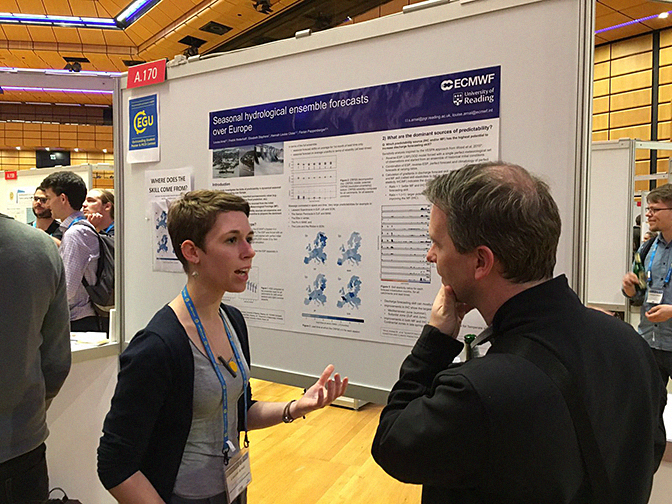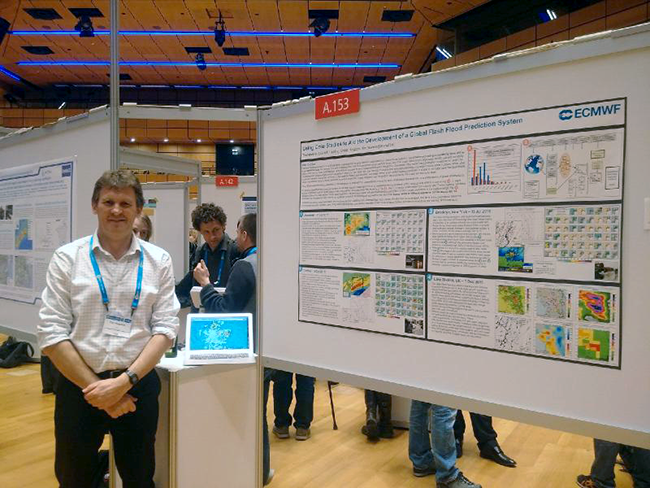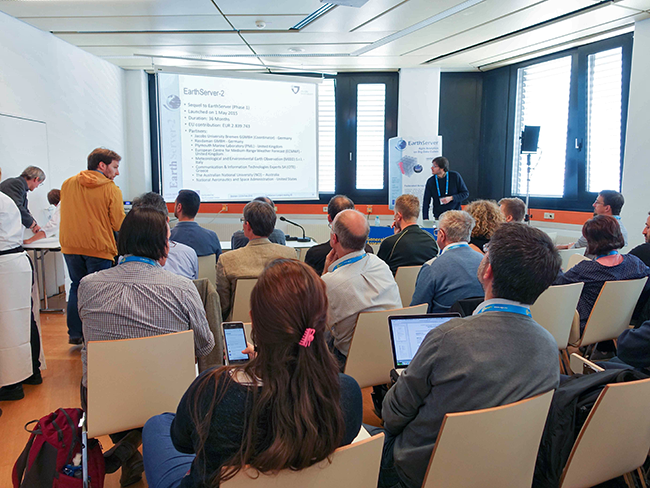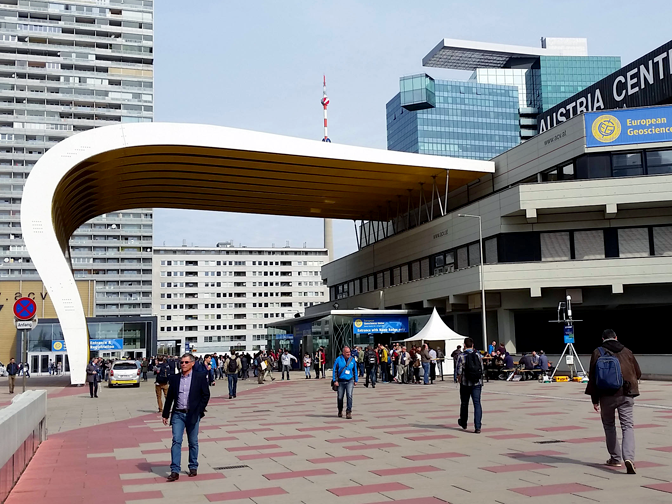

Presentations by ECMWF staff on a new climate reanalysis that went into production earlier this year caused excitement among fellow scientists attending the European Geosciences Union General Assembly in Vienna from 17 to 22 April.
Other talks given by the Centre’s scientists also attracted a lot of interest and led to the prospect of international collaboration.
The EGU General Assembly was attended by 13,650 scientists from 109 countries, according to the organisers.
Reanalysis
ERA5, a new ECMWF global climate reanalysis, will cover the satellite period from 1979 to the present. It will replace ERA-Interim, which was launched in 2006.
Jean-Noël Thépaut, the Head of the EU-funded Copernicus Climate Change Service (C3S) being implemented by ECMWF, gave details about ERA5 in a series of presentations on C3S.
“The news that ERA5 has gone into production sparked a lot of interest from scientists who have been using ERA-Interim,” he said.
Thomas Haiden from ECMWF’s Forecast Department noted that ERA-Interim was referenced in a large number of presentations.
“What was striking to me was the number of studies in which ERA-Interim is used. It is clearly the reanalysis of choice for large-scale atmospheric process studies and verification,” he said.

The programme included nearly 5,000 oral presentations, more than 10,000 poster sessions, 619 scientific sessions and 321 side events.
Reanalyses provide a numerical description of the recent climate by combining models with observations.
ERA5 is the first reanalysis produced at ECMWF as part of C3S.
Among other innovations, it will provide data at a much higher spatial and temporal resolution than ERA-Interim (31 km and hourly, compared to ERA-Interim’s 79 km and 3-hourly), and it will include an uncertainty estimate. It uses the latest version of ECMWF’s Integrated Forecasting System to assimilate observations.
Jean-Noël told EGU delegates that ERA5 production will be completed towards the end of 2017, after which it will be updated in near real-time.
He also took the opportunity of a session on climate services and a separate one on open access to climate information to explain what C3S as a whole will deliver to the community.
Collaboration
Emanuel Dutra from the Research Department captivated his audience with a presentation on the warm bias seen in numerical weather prediction models during the polar night over Antarctica.
“Other modelling and observational groups said they would like to deepen their understanding of our representation of very stable conditions over snow and ice surfaces,” Emanuel said. “They would also like to share the detailed observations they have.”

Tim Hewson presented a poster on his work on a global flash flood prediction system.
Julia Wagemann from the Forecast Department contributed to a presentation on the Horizon 2020 EarthServer 2 project, which aims to make Big Earth Data more accessible to users across scientific domains through well-established OGC web interfaces.
The project partners held a three-hour session to demonstrate how EarthServer 2 can help build web applications using diverse datasets.
The demo session and Julia’s poster presentation on ECMWF's role in the project showed that there is great interest in retrieving ECMWF data through these kinds of services.
Louise Arnal from the Forecast Department presented her research on the sources of predictability in seasonal streamflow forecasting over Europe, while her colleague Tim Hewson talked about his work on a global flash flood prediction system.
In a separate presentation, Tim described diagnostic studies into what might cause very occasional ‘jumps’ in ECMWF ensemble forecasts, which created a lot of interest and triggered several questions.
Louise and her colleagues Florian Pappenberger and David Lavers are also involved in the Horizon 2020 IMPREX project, which co-organised a session highlighting the use of sub-seasonal to seasonal (S2S) weather forecasts and climate projections for water sector applications in a changing climate.
Inspiration
ECMWF’s delegates were unanimous in saying that attending the conference had been worthwhile.

The EarthServer session was well attended.
“I’ve come back with a lot of inspiration, motivation and new ideas for our involvement in the EarthServer project,” Julia noted.
“I noticed a bigger emphasis on early career scientists in the Hydrological Sciences Division this year, which is great,” Louise observed.
For Tim, the conference was a “feast of science”.
“The presentations I attended were overall of high quality both scientifically and in terms of presenting style,” Thomas said.
His own contribution, on the representativeness of surface observations in the Arctic, fitted well into the programme.
“Meteorology has now become a more substantial part of the EGU programme, especially themes where interdisciplinary aspects are important, such as Arctic change and predictability.”

Like last year, the EGU General Assembly took place at the Austria Center Vienna. Next year's edition will be held in Vienna from 23 to 28 April 2017.
Top photo: Louise Arnal explains her work on the sources of predictability in seasonal streamflow forecasting over Europe.
